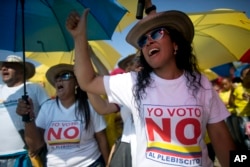A final peace agreement between Colombia’s government and a national guerrilla movement was signed Monday, bringing an end to the longest-running insurgency in the Western Hemisphere.
“Nobody has given up their ideology,” said the maximum leader of the Revolutionary Armed Forces of Colombia (FARC) Rodrigo Londono (better known by his alias of Timochenko), in a speech after signing the peace pact with Colombian President Juan Manuel Santos.
The rebel leader asked for forgiveness for all the harm his movement had caused over the decades.
FARC’s funding was primarily derived from the country’s illicit cocaine industry, and its armed movement was the last full-blown one inspired originally by Cuban and Soviet ideology against democratic institutions in the Americas.
“No more war,” declared Colombian President Juan Manuel Santos in his remarks following Timochenko. “I welcome you to democracy, change weapons for votes and weapons for ideas.”
The conflict since the mid-1960s displaced millions of people and left more than 250,000 dead.
The front page of Monday’s El Tiempo newspaper put it more precisely: "La paz luego de 267,162 muertos. (Peace after 267,162 dead)."
Speaking to the press after the signing of the agreement, U.N. Secretary-General Ban Ki-moon said he normally wouldn’t travel during the opening days of the U.N. General Assembly, which is currently taking place in New York, but he wanted to reinforce his personal commitment to the peace process in Colombia.
“I commend the parties for their adherence to the cease-fire, and for the initial release of a group of minors from the FARC-EP,” he said. “Both sides have also acknowledged responsibility for human rights violations during the decades of conflict – an important admission that can help the process of healing.”
Ban said the U.N. already has 200 unarmed observers on the ground in Colombia working with victims, and the organization “will remain vigilant” in moving forward with the ceasefire.
U.S. Secretary of State John Kerry told reporters Monday in the Caribbean port city, founded in the 16th century, that depending on the implementation of the peace pact, the United States could remove the FARC from its terrorism list.
“The announcement is an idea,” Kerry said. “The implementation are facts, so let’s see how it proceeds, but we clearly are prepared to review and make judgments about that as the facts come in.”
De-mining
The FARC also has agreed to cooperate with de-mining, an effort being led by the United States and Norway.
Colombia has the second highest number of land mines in the world after Afghanistan, and the explosives have killed an estimated 11,500 people since 1990.
The United States is taking some of the credit for bringing about the peace pact, which diplomats in Washington describe as a transformational event for Colombia and the region and one that President Barack Obama has described as one of the most important achievements during his presidency.
Colombian President Santos, who has staked his reputation on ending the war, had asked the United States to increase its engagement in the four-year negotiating process, which mostly took place in Cuba. A special envoy, Bernard Aronson, was named to participate in the talks.
“This war is all about real people and real suffering, and seeing that come to an end is very, very gratifying,” Arsonson told VOA hours before the ceremony.
The U.S. government, in fiscal 2017, plans to spend $450 million to help Colombia bring government services, security, police, education, health, roads and economic development to the vast stretches of the interior that have been left out of national life during the decades of conflict.
Proponents of the deal also note the commitment to work with farmers to get land titles as well as access to transportation networks for their harvests of legal crops, rather than coca leaf production. It includes transitional justice efforts that proponents hope will lead to reconciliation in the countryside.
They also predict it will be the catalyst for Colombia’s GDP to grow at twice its current pace and triple foreign investment following years of negative growth and capital flight.
“It’s very hard to beat the economics of coca but it comes with coercion and violence,” said Marcela Escobari, assistant administrator for the Latin America bureau of the U.S. Agency for International Development.
Hoping compromise pays off
Not everyone supports the deal on which Colombians will render a verdict in a nationwide binding referendum set for October 2.
Former Colombian President Alvaro Uribe contends the deal gives total amnesty to drug trafficking by labeling it a political crime. He said, “Colombians have learned over decades of attempted negotiations with other terrorist groups that impunity always becomes the seed of new forms of violence.”
Recent public opinion polls in the country, however, show a double digit advantage for the “Yes” camp, despite widespread loathing for FARC and a robust “No” campaign spanning the political spectrum.
"The consequences of a loss would be catastrophic," Humberto de la Calle, the government's chief negotiator, said in announcing the agreement.
Other peace threats
The peace pact includes a large new security commitment by Colombia’s government to go after the extremely violent "bandas criminales" (known by the acronym BACRIM). Some are successors to right-wing paramilitaries that clashed with FARC fighters and other left-wing guerrillas, but also engaged in cocaine production and smuggling along with the killings of labor and human rights activists.
The immediate, biggest threat to the October 2 peace referendum could be low voter turnout. To be valid, the referendum must be endorsed by at least 13 percent of all registered voters.
Besides BACRIM, the smaller Marxist-Leninist rebel National Liberation Army, or ELN, remains active, and even with the Cartagena signing, total peace in Colombia will remain elusive.












